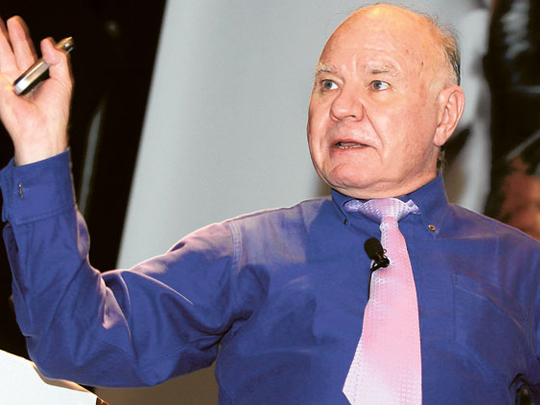
Dubai: Gold is nowhere near a bubble phase and there is no better time to buy it than now considering the violent volatility global markets could face in the context of the economic uncertainties and excessive liquidity central banks are pumping in.
That's the opinion of Marc Faber, an unconventional economist who edited the Gloom, Doom and Boom report released in Dubai last week.
"I don't believe gold is heading into a bubble," Faber said.
"A bubble is characterised by the majority of market participants being involved in a market space. I saw a gold bubble in 1979-1980, when the whole world was dealing — buying and selling gold 24 hours a day, globally."
Faber said the rush by central banks across the world to monetise massive government debts will result in negative real interest rates, asset price inflation and debasing of all major currencies.
Considering the threat of huge value erosion of both real and financial assets in the future as a result of the cheap money policy pursued by governments, Faber said all classes of investors should keep gold as an integral part of their portfolios.
According to Faber the safe haven charm of US Treasuries will be short-lived as the bulk of liquidity will come back to haunt them in the form of inflation in the future.
The economist predicted that the time is not far off when investors will begin to shun US Treasuries.
"The US will pay the interest as long as it can print money," Faber said.
"But suppose you buy a ten-year government bond that yields 2 per cent and inflation is perceived to be 5-7 per cent. To what extent would investors still buy these bonds? That question is not too far away."
US default looming
He said at some point people will wake up to the reality that the US is in default through a depreciating currency — in other words, by printing money.
Printing more money will weaken the currency and produce higher inflation in consumer prices, asset prices and commodity prices. So being in US government bonds will result in losses to investors.
Faber argues that negative real interest rates will eventually force people to speculate, which could create enormous market volatility.
He expects the cash remaining on the sidelines may not go into equities. It could go into some other asset classes, perhaps hard currencies such as gold and silver, or real estate, which is now relatively inexpensive in the US.
Faber is not ruling out corrections in gold prices in a risky market where the level of speculation will be high and will have a bearing on all asset prices.
"All I'm saying is that, in my opinion, the gold price correction is not yet entirely completed," he said.
"I see significant support around the $1,500 an ounce level, but it could drop lower."
He said in the short to medium term the gold price depends on global liquidity and on money printed by central banks.
"We could have a big correction if global liquidity tightens or they stop printing money," he said.











